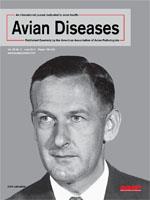Avian paramyxoviruses (APMVs) are classified into nine different serotypes (APMV 1–9). Virulent strains of APMV-1 are already well characterized as the etiologic agent of Newcastle disease (ND), an important disease in poultry that is potentially capable of infecting all orders of avian species. However, very little is known about the other eight serotypes, the majority of which can cause disease in domestic birds. The role of synanthropic and semi–free-range birds as reservoirs of avian paramyxoviruses is not well understood and the main objective of this work was to evaluate the seroprevalence of APMV 1–9 in these kind of birds. A total of 296 sera, oropharyngeal swabs, and cloacal enemas were collected from semi–free-range birds belonging to four different species: feral pigeons (Columba livia var. domestica), hybrid ducks (Anas sp.), domestic geese (Anser anser domesticus), and white storks (Ciconia ciconia). Antibodies against NDV were found in 56.3% of domestic geese, 42.9% of feral pigeons, and 30.4% of hybrid ducks. Antibodies for other APMVs (-3, -4, -6, -7, -8, -9) were also found. Seven positive individuals were positive to real-time RT-PCR detection, all of them feral pigeons captured in 2006 and 2007. The results obtained reinforce the idea that semi–free-range birds may be good sentinels for the detection of NDV and other avian paramyxoviruses.
Nota de Investigación—Seroprevalencia de paramixovirus en aves sinantrópicas y en aves mantenidas en semilibertad.
Los paramixovirus aviares (APMVs) se clasifican en nueve serotipos diferentes (APMV 1–9). Las cepas virulentas del paramixovirus aviar serotipo 1 (APMV-1) ya están bien caracterizadas como el agente etiológico de la enfermedad de Newcastle (ND), una enfermedad importante en la avicultura que es potencialmente capaz de infectar a todos los órdenes de las especies aviares. Sin embargo, se sabe muy poco acerca de los otros ocho serotipos, la mayoría de los cuales pueden causar enfermedades en aves domésticas. El papel como reservorios de paramixovirus aviares de las aves sinantrópicas y en condiciones de semilibertad no se ha comprendido adecuadamente y el objetivo principal de este trabajo fue evaluar la seroprevalencia de los paramyxovirus aviares serotipos 1 al 9 en este tipo de aves. Se recolectaron un total de 296 sueros, hisopos orofaríngeos y enemas cloacales de aves en semilibertad pertenecientes a cuatro especies diferentes: palomas domésticas (Columba livia var. domestica), patos híbridos (Anas sp.), gansos domésticos (Anser anser domesticus) y cigüeñas blancas (Ciconia ciconia). Se encontraron anticuerpos contra el virus de Newcastle en el 56.3% de los gansos domésticos, en el 42.9% de las palomas y en el 30.4% de los patos híbridos. También se encontraron anticuerpos para otros paramyxovirus aviares (-3, -4, -6, -7, -8, -9). Siete individuos positivos también fueron positivos para detección por transcripción reversa y PCR en tiempo real, todas estas aves fueron palomas capturadas entre los años 2006 y 2007. Los resultados obtenidos refuerzan la idea de que las aves en semilibertad pueden ser buenos centinelas para la detección del virus de la enfermedad de Newcastle y de otros paramixovirus.





